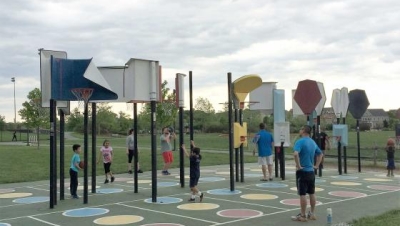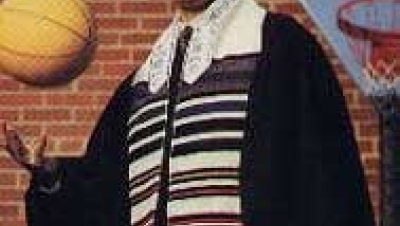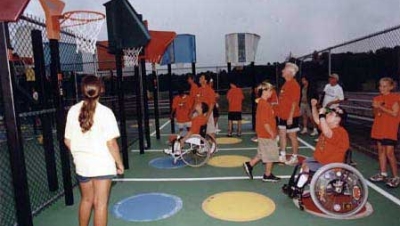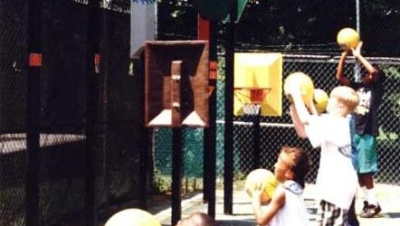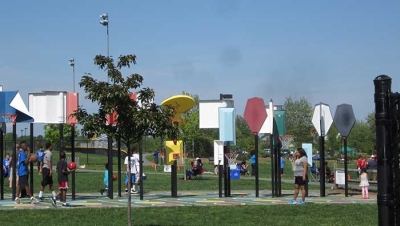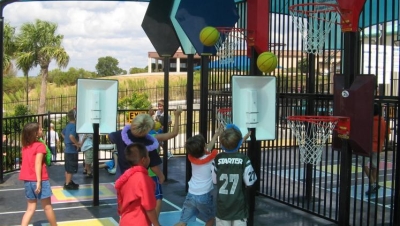
Reeve Robert Brenner is not your average rabbi. Your average rabbi's signature is not on his own line of basketballs, as Brenner's is. And even if it were, your average rabbi probably couldn't keep one of those balls spinning on his fingertip, as Brenner can. But let's say, for argument's sake, that your average rabbi can spin the ball. He surely would never do such a thing in front of the congregation. Brenner did. About a decade ago Brenner, performing at the pulpit of Temple Emanuel in Cherry Hill, N.J., spun a basketball before a couple hundred rather amazed temple goers. No, he's not your average rabbi.
Basketball has always been a big part of the 55-year-old Brenner's life. It was the favorite game of his youth in the Borough Park section of Brooklyn, and he has continued to play as an adult--from pickup games in Bethesda, MD., where he now lives, to New York City to Tel Aviv. To hear Brenner tell it, he isn't your average basketball player, either. "If you add up all the points I've scored, rebounds I've taken, fouls I've committed, shots and steals," he says, "I don't know anybody who could put up those kinds of numbers, unless they've played three times a week for 30 years like I have."
Having outdone--at least in his own mind--Abdul-Jabbar, Chamberlain and Russell, Brenner has recently taken after another basketball legend: James Naismith. Brenner, too, has founded a basketball game. It's called Bankshot™. It's a radically modified version of the sport, and it allows wheelchair and able-bodied athletes to compete against one another without giving special allowances to either group.
Inspired by his young cousin, Janice Herman, who was confined to a wheelchair after an automobile accident, Brenner Came up with Bankshot™ while living in Israel in 1981. He wanted to develop a "nonexclusionary" basketball contest that entire families, including those with disabled members, could play. Bankshot Backboards™ have been displayed in New York City's Museum of Modern Art and in the Israel National Art Museum in Jerusalem. This is only fitting, inasmuch as Brenner cites modern art giants Picasso, Kandinsky and Moreau as influences on his designs.
Brenner, the sport's Wilt as well as its Naismith, is the only player known to have reached 200 points, but he is now semiretired. "The inventor has got to make room for the players," he explains. Brenner sees Bankshot™ as a "turn in the world of sports. The world is full of running sports, and there are not a sufficient number of sports where different levels can play together." Not yet. If Brenner has his way, there will be. In addition to Bankshot™, he has thought up 23 other "total mix" games.
Total-mix games have their roots in Brenner's spiritual creed, which he terms "polydox," from poly, meaning many, and doxy, for doctrine. "Mine isn't a view that says there's one way of doing something," he says. "My feeling is that different expressions of theology or theory have validity." Brenner's polydoxical ideas are espoused not just through sports, but from the pulpit at the Bethesda Jewish Congregation, one of the more liberal in the Washington, D.C., area. Brenner's life has long been a polysided pursuit, a total mix. The son of a monument maker, he grew up competing in all sports and was a good athlete.
He played basketball at Brooklyn's Yeshiva University High School, which was located a few blocks from Ebbets Field. The school's gymnasium had a low ceiling, and this feature obviously influenced the future inventor of Bankshot™. "Reeve learned how to put shots off the ceiling," says Zalman Schrader, a West Orange, NJ, physician who grew up with Brenner. "That could be where he got the idea for his game." Brenner played hoops at Brooklyn College and on a team from CCNY's Baruch School of Business Administration. He did graduate work in social psychology at CCNY and then studied to become a rabbi at Hebrew Union College-Jewish Institution of Religion in Manhattan.
Between 1964 and '66, Brenner was an Army chaplain in West Germany. He taught Jewish religious thought and philosophy at St. Vincent College and Seminary in Latrobe, Pa., for two years; lived in Israel; and served at other congregations up and down the East Coast, finally landing in Maryland in 1986. He still plays an occasional game of real basketball, usually at the Jewish Community Center in Rockville, Md. "He's ultratenacious," says Wayne Pines, a Washington public relations executive and congregation member who often plays with Brenner. "And without a question, he's the best shooter on the court."
Brenner works out of a Bethesda office that doubles as Bankshot's™ national headquarters and as his counseling center. On one wall is a caricature of Brenner dunking a basketball and shouting, "Polydox .... Total mix .... Bankshot™ .... Blah, blah, blab." Brenner loves it. Brenner is, as you might expect, always dreaming up new things in that cramped office. His latest grand scheme is to open a "folk sports" theme park, a family-oriented site that would feature all of his total-mix games. "It's the next step beyond Disney," he says. Those who know Brenner don't doubt that the park will rise one day. "His approach is very powerful at times," says Ovesen. "He has a very sincere belief in what he's doing."
"People often think of rabbis as stern and humorless," says Brenner. "When they meet me, they're surprised. I'm the kind of person who breaks down stereotypes." And walls.


